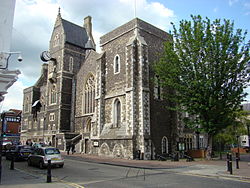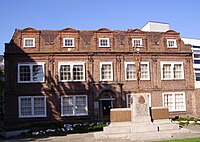Maison Dieu, Dover
| Maison Dieu | |
|
Kent | |
|---|---|
 Maison Dieu and the later town hall behind | |
| Type: | town hall |
| Location | |
| Location: | 51°7’41"N, 1°18’32"E |
| Town: | Dover |
| History | |
| town hall | |
| Information | |
| Owned by: | Dover Town Council |
Maison Dieu (meaning 'House of God') is a prominent mediæval building in Dover in Kent, and which today forms part of the Old Town Hall buildings.
In the Middle Ages the house served as a hostelry under monastic government, and was known as 'The Hospital of St Mary, Domus Dei, or Maison Dieu'
History
Mason Dieu was founded in 1203 by Hubert de Burgh, the Constable of Dover Castle, as the "Hospital of the Mason Dieu" to accommodate pilgrims coming from the Continent to visit the shrine of Thomas Becket in Canterbury Cathedral.[1] de Burgh gave the manors of River and Kingsdown to the hospital in order to fund it.[2] Simon de Wardune also gave some land.[3]

The original buildings consisted of one large hall with a kitchen and living quarters attached for the Master and Brethren who 'practised hospitality to all strangers'. The hospital accommodated permanent pensioners and other wounded and poor soldiers, as well as pilgrims.
In 1227, a chapel was added and King Henry III attended its consecration. Today, this chapel survives as a courtroom, having been converted in the nineteenth century by the town council of Dover. A "Great Chamber", built in 1253, is thought to be the present 'Stone Hall', which has interesting stained glass and contains the town corporation's civic paintings, Cinque Ports Volunteers regimental flags, arms, and armour.
Dissolution
When the Master and Brethren of the Hall signed an oath accepting King Henry VIII's Act of Supremacy, declaring him the Head of the Church of England, in 1534, the institution's religious role ended. Ten years later, the building was surrendered to the Crown and (with its nearby subsidiary St Edmund's Chapel) was utilized by the navy and army, as a supplies base, until 1830.
Civic role
In 1834, the building was sold to the Corporation of Dover who used the Maison Dieu as the Town Hall.[4] At first, the building was used by the Town Council with minimal restorations. Eventually, the Council turned the old chapel into a courtroom and built a prison below. The Council decided to fully restore the building, and in 1851 they agreed to implement renovations suggested by the architect Ambrose Poynter.
After seven years of fundraising for the project, William Burges, another famous Victorian architect, funded almost entirely by the Council, began work on the restoration project. Burges's admiration of the original mediæval style can be seen in such parts of his renovation as grotesque animals and in the coats of arms incorporated into his new designs.
Burges designed the Council Chamber at the end of the hall added in 1867 and in 1881 began work on a town meeting and concert hall. The new building, on the site of the old prison, contained meeting rooms and mayoral and official offices. While William Burges designed the project, parts were completed after his death by Pullan and Chapple, his partners.
Meeting hall
The Maison Dieu continues to be used as one of the main meeting halls in Dover, as well as being open to public use for functions such as conferences, weddings, fairs, concerts, theatrical performances and the annual White Cliffs Winter Ales Festival.[5]
Outside links
References
- ↑ "The Maison Dieu (Old Town Hall)". dover-kent.co.uk. http://www.dover-kent.co.uk/places/maison_dieu.htm. Retrieved 14 January 2011.
- ↑ Short historical sketch of the town of Dover and its neighborhood. Z. Warren, Ptr.. 1828. p. 24. http://books.google.co.uk/books?id=AmgQAAAAYAAJ&pg=PA24&dq=maison+dieu+dover&hl=en&ei=YTYwTcv8JIOohAealfy9Cw&sa=X&oi=book_result&ct=result&resnum=1&ved=0CCYQ6AEwAA#v=onepage&q=maison%20dieu%20dover&f=false. Retrieved 14 January 2011.
- ↑ The History and Topographical Survey of the County of Kent: Volume 6, Warden ,pages 259–263}}
- ↑ "Dover Museum – Maison Dieu". dover.gov.uk. http://www.dover.gov.uk/museum/dover_history/medievel/maison_dieu.aspx. Retrieved 14 January 2011.
- ↑ "CAMRA in Ashford Folkestone and Romney Marsh Kent". camra-afrm.org.uk. http://www.camra-afrm.org.uk/camra-beer-festivals/venueevents/34-maison-dieu-town-hall. Retrieved 14 January 2011.